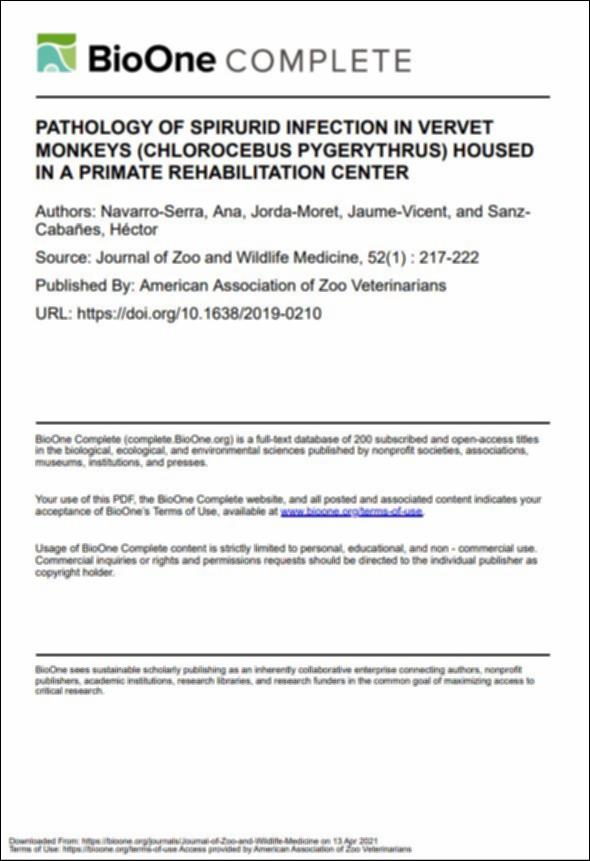Please use this identifier to cite or link to this item:
http://hdl.handle.net/10637/15296Pathology of spirurid infection in vervet monkeys (Chlorocebus Pygerythrus) housed in a primate rehabilitation center

See/Open:
Pathology_Navarro_JZWM_2021.JPG
83,87 kB
JPEG
See/Open:
Pathology_Navarro_JZWM_2021.pdf
Restricted Access
413,35 kB
Adobe PDF
Request a copy
| Title: | Pathology of spirurid infection in vervet monkeys (Chlorocebus Pygerythrus) housed in a primate rehabilitation center |
| Authors : | Navarro Serra, Ana Jordá Moret, Jaume Vicent Sanz Cabañes, Héctor |
| Keywords: | Monos; Monkeys; Enfermedad animal; Animal diseases; Parasitología veterinaria; Veterinary parasitology; Parásitos; Parasites |
| Publisher: | American Association of Zoo Veterinarians |
| Citation: | Navarro-Serra, A., Jorda-Moret, J.V. & Sanz-Cabañes, H. (2021). Pathology of spirurid infection in vervet monkeys (Chlorocebus Pygerythrus) housed in a primate rehabilitation center. Journal of Zoo and Wildlife Medicine, vol. 52, i. 1, pp. 217–222. DOI: https://doi.org/10.1638/2019-0210 |
| Abstract: | Spirurids, specifically the Rictularia, Chitwoodspirura, Streptopharagus, and Protospirura genera, have been reported to parasitize all nonhuman primate taxa. Spirurid pathogenesis in nonhuman primates has not been reported frequently; however, Protospirura muricola has been associated with serious gastric pathologies, including gastric perforation. This study was a retrospective study of 38 vervet monkey (Chlorocebus pygerythrus) necropsies performed in a primate sanctuary that houses captive orphaned or injured wild-born vervet monkeys. Individuals were categorized according to their age, sex, and body condition score to investigate the relationships between these factors and parasite presence. This study identified P. muricola in 47.37% of the necropsied carcasses. Regarding individual factors associated with P. muricola infection, no significant differences between males and females were observed; however, relationships between parasite presence and poor body condition and advanced host age were observed. Furthermore, one monkey death was potentially directly related to spirurid pathogenic action, because the individual showed gastric perforation. |
| Description: | Este recurso no está disponible en acceso abierto por la política de la editorial. |
| URI: | http://hdl.handle.net/10637/15296 |
| ISSN: | 1042-7260 1937-2825 (Electrónico) |
| Issue Date: | 1-Apr-2021 |
| Center : | Universidad Cardenal Herrera-CEU |
| Appears in Collections: | Dpto. Producción y Sanidad Animal, Salud Pública Veterinaria y Ciencia y Tecnología de los Alimentos |
Items in DSpace are protected by copyright, with all rights reserved, unless otherwise indicated.

